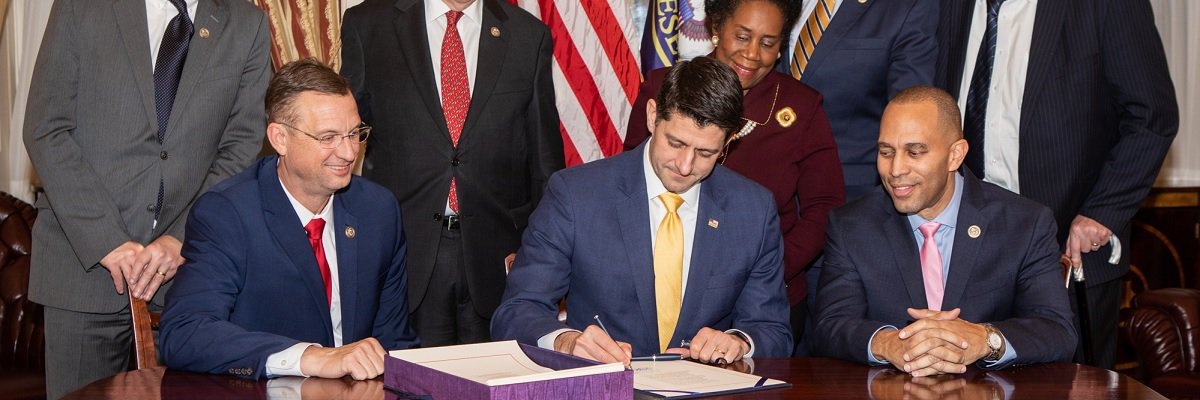More than two months after President Donald Trump signed into law the First Step Act, development of a risk assessment tool central to its implementation is still pending, and it is unclear when formal discussions of the tool’s goals and creation will begin or how much funding the program will actual receive from the federal budget.
“This is an incredible event, an incredible success for our country,” Trump said at the December 21st bill signing, just hours before the federal government began a shutdown of “nonessential” activities. The shutdown lasted 35 days and delayed $18 billion in government activities, including action on First Step, according to estimates by the Congressional Budget Office.
Affected agencies included the Office of Justice Programs, home to the National Institute of Justice, which is responsible for coordinating the First Step’s first steps. During the shutdown, OJP worked with only six percent of its regular staff, according to NIJ spokesperson Sheila Jerusalem. At the time, she told MuckRock inquiries into the program would be addressed once funding had been restored. The government reopened on January 25th.
But there hasn’t been clarity about the status of First Step. “We’re not providing comment at this time,” Jerusalem wrote in email at the end of February. At the beginning of March, she declined again to comment.
A bipartisan effort to address and reduce mass incarceration, the law increases the number of days of prison time waived for good behavior and proposes expansion of access to rehabilitative services. Some inmates have already been released due to the First Step Act’s expanded compassionate release and revised sentencing provisions. But according to U.S. Sentencing Commission estimates, those changes will impact far fewer people than the eventual development of the risk and needs assessment, which could affect as many as 106,000 prisoners.
Full implementation on the new law relies heavily on the creation of a risk assessment tool or the adoption of a tool already in use. The law required NIJ to select an Independent Review Commission within 30 days of the bill’s enactment. Thus far, none of that Commission’s members have been announced. Then, within 180 days of enactment, originally June 19th, 2019, a tool would have been developed to make core assessments, including:
- classification, made at intake, of each federal prisoner’s risk of recidivism
- an assessment of each prisoner’s risk of violent or serious misconduct
- recommendations for the type, amount, and frequency of evidence-based recidivism reduction programs prescribed to each prisoner
The risk assessment tool is expected to be used to periodically reassess risk rates and assignments of former prisoners to “evidence-based recidivism reduction” programs. It is also intended to determine incentives and rewards for successful participation and a prisoner’s readiness for pre-release custody.
There are currently more than 180,000 people in federal custody, and the CBO estimated that implementation of the First Step Act would by 2028 reduce that by more than one-third or about 53,000 prisoners.
## Know of an algorithmic development near you? Click here to let us know.
Despite the law’s passage, many civil rights advocates are concerned about the use of risk assessments by the criminal justice system. Using prior convictions and other crime data, the tools are meant to assist administrators and judges in estimating an offender’s likelihood of future criminal behavior, but these calculations could simply be relying on data rife with biases about the causes of historic crime rates and the details of criminal demographics. Civil rights groups - 119 so far - have signed onto a letter of concern against risk assessment tools, emphasizing the importance of careful development and transparency about situations in which they are being used. The First Step Act had provided for nearly seven months of development time for its risk assessment “system,” which advocates believed would help address upfront concerns about the tool’s use. But the clock is ticking and there is no clear sign that the tools are under development.
Now, with just four months until the mandated public publication of the system and a number of preliminary structural decisions, such as its goals and success metrics, still remaining to be made, the additional 30 days advocates negotiated for during the creation of the bill, meant to promote more thoughtful development, seem to have gone unused.
The original law also approved for appropriation $75 million a year toward implementation, an amount that may not materialize. Trump’s proposed budget for fiscal year 2020, released by the White House last week, only includes an explicit $14 million toward the “new and innovative pilot programs” to be created by the Act with additional funding allocated to reentry programs and the Second Chance Act.
Jessica Jackson, National Director of #cut50, told MuckRock that she believes the Congress could still provide the necessary funding and that the anticipated selection of a new Bureau of Prisons Director will be important to ensuring that the agency’s leadership is committed to the law’s intentions. However, her group is also concerned about delays to other parts of the law’s initiatives being caused due the prioritization of the risk assessment tool.
“I think it’s really bad practice to both be trying to implement a major risk assessment tool and trying to do the recalculations to get people out to halfway houses and their homes,” Jackson said. “I think we should be going ahead and doing the good time credits now and then go and build the risk assessment.

Algorithmic Control by MuckRock Foundation is licensed under a Creative Commons Attribution 4.0 International License.
Based on a work at https://www.muckrock.com/project/algorithmic-control-automated-decisionmaking-in-americas-cities-84/.
Image via Wikimedia Commons




